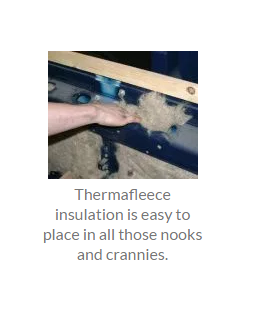Campervan insulation for campervan conversions & van lining
Posted by By; Celtic Sustainables on 26th Jun 2017
Do you sometimes dream of getting away from it all?
For many the idea of packing a few essential things into a campervan, hitting the open road and seeing the world is a fantasy, however more and more people are making that dream come true by reconditioning old campers or converting commercial vehicles for festivals, short-breaks and holidays.
Jake insulating a Fiat Ducato Long Wheel Base van conversion with Thermafleece Cosywool.
We caught up with a local camper van conversion specialist to find out where they are using our products and why.
Poppit Campers Ltd are just a few minutes away from us here in Cardigan. They do everything from VW campervan repairs and renovations to bespoke fully featured motorhome conversions.
Poppit Campers preferred campervan insulation for all their van conversions is Thermafleece. “It’s easy to use, insulates really well and has great sound barrier qualities too” Jake explained as he simply pulled sections of the Thermafleece Cosywool off the roll and placed them against the side of the van and stuffed them into the nooks and crannies of the van interior ready for the interior panelling. “Customers also like the naturalness of the product”.
Thermafleece Natural wool and recycled fibre insulation is easy to place in all those nooks and crannies.
Thermafleece is made from natural and recycled materials and while being great for the environment and your health (it doesn’t give off VOCs) it has other qualities too – it doesn’t cause condensation when installed in the van. “Some other insulation products can sweat and cause condensation to drip. We’ve never had any problems with Thermafleece” said Jake reflecting on an occasion when they had been asked to investigate damp patches that kept forming on a carpeted campervan floor, converted by someone else we hasten to add.
The high percentage of wool in the insulation (75% wool) means that any possible moisture build up in the van does not cause condensation. Wool is hygroscopic – it absorbs, retains and releases moisture without affecting its thermal properties. This makes is perfect for use campervans (and anywhere where moisture is a concern).
Here at Celtic Sustainables, we sell thermafleece by the roll to the whole of the UK so if you are embarking on a motorhome conversion, whether you are doing it yourself or paying a van conversion specialist, check out our natural insulation prices online.
Sunrise - The traditional, practical everyday conversion with spacious interiors and up to 4 berth from Poppit Campers. Image copyright Poppit Campers Ltd
 Thermafleece natural insulation
Thermafleece natural insulation
For internal applications, we recommend Thermafleece natural insulation. Made from natural and recycled materials, the range of Thermafleece products can be used for thermal and acoustic insulation as well as for floors and roofs. The wool, hemp, and recycled products meet the highest demands of traditional and modern construction whilst ensuring minimal environmental impact. Shop for Thermafleece here.
How Natural Insulation benefits the Environment
Using a non-breathable insulation either on the interior or exterior surface of the wall, or even in the inside of the wall itself, will prevent the wall from breathing and therefore cause it to hold moisture instead of letting it evaporate. Natural insulation, on the other hand, allows moisture to leave the walls. These insulating materials keep the walls and the home warm in the winter and cool in the summer, and stop the walls from degrading with time.
In the loft, good ventilation and a low temperature help to preserve the old timbers which support the roof. Coolness deters warmth-loving insects from living in and eating the timber. Using natural insulation in the ceiling between the house and the loft, we are able to keep warmth in the living space from leaking through to the cooler space above.
The Benefits of Natural Insulation
There are many benefits of using natural insulation, including:
- Materials such as sheep’s wool and hemp take less energy to manufacture, helping reduce carbon emissions
- Natural insulations are breathable, stopping moisture from becoming trapped inside the house and causing damp and mould to form
- The insulation can be recycled at the end of its life
- Sheep’s wool and hemp is non-itch, non-irritant, and safe throughout its lifetime
- Natural materials work at least as well or even better than conventional insulations
- Natural insulation is fire-proof and rodent-resistant
- Natural insulations provided by Celtic Sustainables are made in the UK, so the shipping is kept to a minimum
Sheep’s Wool Insulation
Sheep’s wool is a traditional insulation we’ve all felt the benefits of before (your warmest winter jumpers probably kept a sheep warm once upon a time), and it’s a real wonder-product for warming a whole house, too. Wool fibres act as a humidity buffer and absorb indoor pollutants such as formaldehyde, and as wool grows it abrobs nearly 140 million kg of CO2 from the atmosphere here in the UK alone – that’s equivalent to emissions from 35,000 family cars! As wool regenerates, this is repeated year upon year. Thermalfeece wool insulations come in all shapes and sizes to suit your project.
Breathability
One of the major benefits of using a natural insulation instead of a conventional insulation is its breathability. Other materials are not very good at allowing moisture to escape from the house, and can lead to dampness forming between joists or wherever the material is placed. This is no good either for you or the house! Natural materials have had plenty of time to perfect their own ways of letting moisture out, and have become better than anything else at doing so.
Van Lining
Many people decide to use a quality Vapour Barrier for their campervan conversion projects (which when installed correctly will stop any moisture from getting through to the cavity). Other customers have chosen to use a Breather Membrane which also has the benefit of releasing any moisture that may get trapped in the cavity. If you would like to discuss your eco insulation and van lining options, please do not hesitate to contact us.


